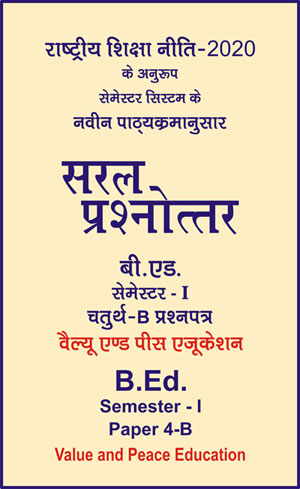|
बी एड - एम एड >> बी.एड. सेमेस्टर-1 प्रश्नपत्र-IV-B - वैल्यू एण्ड पीस एजुकेशन बी.एड. सेमेस्टर-1 प्रश्नपत्र-IV-B - वैल्यू एण्ड पीस एजुकेशनसरल प्रश्नोत्तर समूह
|
5 पाठक हैं |
||||||
बी.एड. सेमेस्टर-1 प्रश्नपत्र-IV-B - वैल्यू एण्ड पीस एजुकेशन (अंग्रेजी भाषा में)
Question- Write a short note on Environmental Issue and Indian Laws.
Answer -
Some of the major environmental concerns confronting India include :
(a) Air pollution from industrial effluents and vehicle emissions;
(b) Energy-related environmental problems such as, chemical & oil pollution and Greenhouse Gas (GHG) emissions (Greenstone and Hanna);
(c) Water pollution from raw sewage, the lack of adequate sanitation, and non-potable water throughout the country;
(d) Municipal solid waste management (MSWM) remains a challenge for India due to the rising population and the resultant infrastructural needs (Dube, Nandan, and Dua);
(e) Over-population and its strain on natural resources; and
(f) Agricultural factors such as, runoff of agricultural pesticides, overgrazing, short cultivation cycles, slash and burn practices, destructive logging practices, and deforestation of timber reserves for fuel, all contribute conjointly to the decimation of the subcontinent’s environmental system (Greenstone and Hanna).
In particular, municipal solid waste (MSW) collection and disposal is a major urban environmental problem facing India. India is not the only country with this problem, it appears many of the developing countries and a few of the developed countries are also confronted with MSW as an environmental concern. But, in India the critical concern is in the way MSW is disposed. The waste that is collected by municipalities in India is simply dumped on the outskirts of the urban centers (Reddy). In addition the MSW release methane and carbon dioxide that increase the effects of greenhouse gases.
On environmental issues and concerns, India carries a heavier burden because it is generally accepted that pollutant concentrations are exceedingly high in many developing countries imposing substantial health costs and shortened lives (Chen, et. al., 2013). Since most of the growth in greenhouse gas (GHG) emissions is projected to occur in developing countries such as China and India, these two countries are probably responsible for the future of this world. In the most recent data available, ambient particulate matter concentrations in India are five times the level of concentrations in the United States and China’s are seven times the U.S. level (Greenstone, 2014). Interestingly, in anticipation of the Paris Conference on climate change that is scheduled to start on November 30th, countries have been issuing pledges about how much emission they are willing to cut in coming decades. India and Brazil, probably the two of the most air polluting countries in the world have yet to make commitments to take to the Paris Conference (Gillis and Sengupta).
|
|||||













